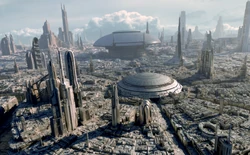| | |
- "Thousands of layers of buildings and skyscrapers cover the entire planetary surface of Coruscant. Because of this, Coruscant is one of only a handful of city-planets, known as an 'ecumenopolis.'"
- ―Recording for Coruscant newcomers

As the hub of galactic activity, Coruscant was a well-known ecumenopolis.
An ecumenopolis was a planet[1] or moon[2] entirely encompassed by a single city.[1] Due to their lack of exploitable ground, such world-spanning cities were dependent on imports for food and raw materials.[3]
There were only a handful of ecumenopolis in the galaxy.[1] Many of them, such as the galactic capitals of Coruscant[3] and Hosnian Prime,[4] as well as Denon[5] and Eufornis Major,[6] were situated in the Core Worlds; others were in the Deep Core, such as Troithe,[7] and Empress Teta.[8] City-worlds in the Outer Rim Territories included Botajef,[9] Nar Shaddaa,[2] Taris,[10] Uchinao,[11] and Wind.[12]
Behind the scenes[]
The first ecumenopolis seen on-screen within Star Wars was Coruscant in The Star Wars Trilogy Special Edition, released in 1997.[13] The term made its first Star Wars appearance in the Legends novel Coruscant Nights I: Jedi Twilight, in 2008.[14] In Star Wars canon, the term was first used in the 2015 novel Heir to the Jedi, written by Kevin Hearne.[5]
Appearances[]
Sources[]
 Star Wars: Build Your Own R2-D2 2 (Droid Directory: 3PO-series Protocol Droids, Part 1) (Picture only)
Star Wars: Build Your Own R2-D2 2 (Droid Directory: 3PO-series Protocol Droids, Part 1) (Picture only) Star Wars: Build Your Own R2-D2 3 (Droid Directory: R2-series Astromech Droids, Part 2) (Picture only)
Star Wars: Build Your Own R2-D2 3 (Droid Directory: R2-series Astromech Droids, Part 2) (Picture only) Star Wars: Build Your Own R2-D2 4 (Droid Directory: 3PO-series Protocol Droids, Part 1) (Picture only)
Star Wars: Build Your Own R2-D2 4 (Droid Directory: 3PO-series Protocol Droids, Part 1) (Picture only) Star Wars: Build Your Own R2-D2 5 (Droid Directory: 2-1B-series Medical Droids, Part 1) (Picture only)
Star Wars: Build Your Own R2-D2 5 (Droid Directory: 2-1B-series Medical Droids, Part 1) (Picture only) Star Wars Helmet Collection 71 (Databank A-Z: Zam Wesell–Wexley) (Indirect mention only)
Star Wars Helmet Collection 71 (Databank A-Z: Zam Wesell–Wexley) (Indirect mention only)- Star Wars Search and Find Volume I
- Star Wars: The Galactic Explorer's Guide
 Star Wars: Card Trader (Card: Zam Wesell - Topps' Women of Star Wars)
Star Wars: Card Trader (Card: Zam Wesell - Topps' Women of Star Wars)"Anakin Skywalker" — Star Wars Encyclopedia
 Star Wars Inside Intel: Clone Armor on StarWars.com (article) (backup link)
Star Wars Inside Intel: Clone Armor on StarWars.com (article) (backup link) Star Wars Inside Intel: Coruscant on StarWars.com (article) (backup link)
Star Wars Inside Intel: Coruscant on StarWars.com (article) (backup link)- Star Wars: The High Republic: Chronicles of the Jedi
Notes and references[]
- ↑ 1.0 1.1 1.2 1.3
 The Mandalorian — "Chapter 19: The Convert"
The Mandalorian — "Chapter 19: The Convert"
- ↑ 2.0 2.1 Star Wars (2015) 8
- ↑ 3.0 3.1
 Coruscant in the Databank (backup link)
Coruscant in the Databank (backup link)
- ↑ Star Wars: The Force Awakens: The Visual Dictionary
- ↑ 5.0 5.1 Heir to the Jedi
- ↑ Servants of the Empire: Rebel in the Ranks
- ↑ Shadow Fall
- ↑ Star Wars: The Force Awakens Beginner Game
- ↑ Thrawn
- ↑ Aftermath: Empire's End
- ↑ Alphabet Squadron
- ↑ The Vow of Silver Dawn
- ↑ Star Wars: Episode VI Return of the Jedi
- ↑ Coruscant Nights I: Jedi Twilight
